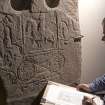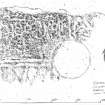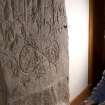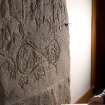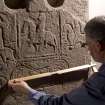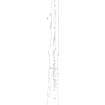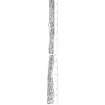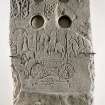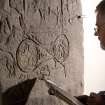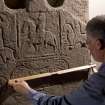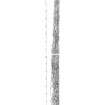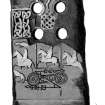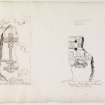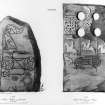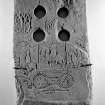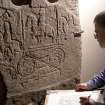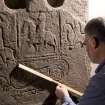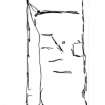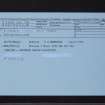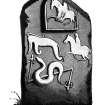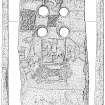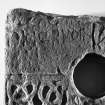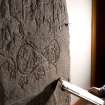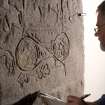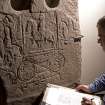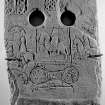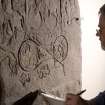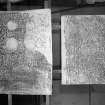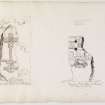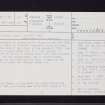Auchenblae, Fordoun Parish Church, Fordoun Stone
Cross Slab (Pictish), Ogham Inscribed Stone (Pictish), Pictish Symbol Stone (Pictish)
Site Name Auchenblae, Fordoun Parish Church, Fordoun Stone
Classification Cross Slab (Pictish), Ogham Inscribed Stone (Pictish), Pictish Symbol Stone (Pictish)
Alternative Name(s) St Palladius's Chapel; Fordoun Parish Churchyard, Saint Palladius' Chapel; Auchenblae Village
Canmore ID 36458
Site Number NO77NW 3.02
NGR NO 7261 7841
Datum OSGB36 - NGR
Permalink http://canmore.org.uk/site/36458
- Council Aberdeenshire
- Parish Fordoun
- Former Region Grampian
- Former District Kincardine And Deeside
- Former County Kincardineshire
Fordoun (St Palladius), Aberdeenshire, inscribed Pictish cross-slab fragment
Measurements: H 1.50m, W 0.84m, D 0.09m
Stone type: red sandstone
Place of discovery: NO 7261 7841
Present location: in the vestibule of Auchenblae Church, clamped to the wall.
Evidence for discovery: found in the late eighteenth century re-used horizontally as the base for the pulpit in the old parish church when it was demolished and placed in St Palladius Chapel. It was first recorded by Stuart in 1822, missing the top and with the right-hand portion having flaked away. The missing surface was restored in concrete sometime before 1848, and the slab was fixed to the wall inside St Palladius Chapel probably in 1872 when the chapel itself was restored. In 1966 it was moved into the adjacent parish church. The ogham inscription was first noticed in the late twentieth century.
Present condition: weathered and incomplete, lacking the upper part and the upper part of the right-hand side. A fragment of the slab is said to have been found around 1966 but was not retained.
Description
A substantial rectangular slab, this is carved on one broad face in a mixture of incision and low relief, and there are ogham inscriptions carved on the narrow faces. The upper part of face A bears an equal armed cross with large closed armpits which are hollowed through the slab. The cross is outlined by a narrow roll moulding and the arms and central panel are carved in low relief. The left-hand arm contains a double ring-knot, the central panel another ring-knot, and the lower arm a horseman riding to the left. The horse is trotting and has a long tail, and the reins and saddle-cloth are clearly shown. The bearded rider wears a short cloak over a sword and has a spear in his right hand. Traces of one or more beasts can be made out in the stump of the upper arm, but the right-hand arm is missing altogether. Flanking the upper arm on the left are two lines of an inscription in Latin miniscule letters, reading PIDARNOIN, probably a personal name. Flanking the lower arm are incised two more horses, that on the left trotting and that on the right leaping. Their riders appear to be shown without saddle-cloths and armed only with spears. There are traces of a possible hound above the left-hand horseman.
Set squarely below the cross is an incised horizontal double-disc and Z-rod with internal spiral decoration, and the rear half of an animal survives to the left. There are ogham letters inscribed on faces B and D which may originally have continued over the top of the stone, face E. Face C appears to be blank.
Date: eighth or ninth century.
References: Stuart 1822, 318-20; ECMS pt 3, 201-3; Fraser 2008, no 21.
Compiled by A Ritchie 2017
Field Visit (6 December 1967)
The Fordoun Stone, as described, was placed within the church in 1966 (information from Rev K T Thomson, The Manse, Auchenblae) having been moved from within the chapel NO77NW 3.00.
Visited by OS (R L) 6 December 1967.
Desk Based Assessment (1967)
NO77NW 3.02 7261 7841.
In the vestibule of Fordoun parish church (at NO 7260 7844) there is a Class II 'Pictish' cross-slab which had been used as the base of the pulpit of the church of 1788. The face bears a Latin cross, part of a 'sea monster', a double-disc and Z-rod, a hunting scene with three horsemen and dogs, and two inscriptions, one in Hiberno-Saxon miniscules (on the face) and the other in Ogam (on the edge). It is named the 'Fordoun Stone' (Jervise 1859).
Information from OS
RCAHMS 1982; A Jervise 1859; J R Allen 1892; J R Allen and J Anderson 1903; J Stuart 1822.
Field Visit (February 1982)
St Palladius' Chapel, Burial-ground and Cross-slab NO 726 784 NO77NW 3
In the vestibule of the present church there is a Class II 'Pictish' cross-slab which had been used as the base of the pulpit in the church of 1788. The face bears a Latin cross, part of a 'sea monster', a double-disc and Z-rod, a hunting scene with three horsemen and dogs, and two inscriptions, one in Hiberno-Saxon miniscules (on the face) and the other in Ogam (on the edge).
RCAHMS 1982, visited February 1982
(Stuart 1822, 318-20; NSA, xi, Kincardine, 66-7; Jervise 1874; MacGibbon and Ross 1896-7, iii, 468-9; Rhys 1898, 347-8; Allen and Anderson 1903, iii, 201-3; Macfarlane 1906-8, i, 267; Cowan 1967, 68)
Field Visit (23 June 2004)
This cross-slab bears two ogham inscriptions, one on each edge.
Visited by RCAHMS (JB) 23 June 2004








































